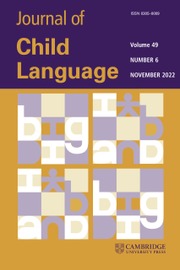Crossref Citations
This article has been cited by the following publications. This list is generated based on data provided by
Crossref.
Reilly, Sheena
Bavin, Edith L.
Bretherton, Lesley
Conway, Laura
Eadie, Patricia
Cini, Eileen
Prior, Margot
Ukoumunne, Obioha C.
and
Wake, Melissa
2009.
The Early Language in Victoria Study (ELVS): A prospective, longitudinal study of communication skills and expressive vocabulary development at 8, 12 and 24 months.
International Journal of Speech-Language Pathology,
Vol. 11,
Issue. 5,
p.
344.
SKEAT, JEMMA
WAKE, MELISSA
REILLY, SHEENA
EADIE, PATRICIA
BRETHERTON, LESLEY
BAVIN, EDITH L.
and
UKOUMUNNE, OBIOHA C.
2010.
Predictors of early precocious talking: A prospective population study.
Journal of Child Language,
Vol. 37,
Issue. 5,
p.
1109.
Ingersoll, Brooke
and
Lalonde, Katherine
2010.
The Impact of Object and Gesture Imitation Training on Language Use in Children With Autism Spectrum Disorder.
Journal of Speech, Language, and Hearing Research,
Vol. 53,
Issue. 4,
p.
1040.
Lock, Andrew
and
Zukow‐Goldring, Patricia
2010.
The Wiley‐Blackwell Handbook of Infant Development.
p.
394.
Botting, Nicola
Riches, Nicholas
Gaynor, Marguerite
and
Morgan, Gary
2010.
Gesture production and comprehension in children with specific language impairment.
British Journal of Developmental Psychology,
Vol. 28,
Issue. 1,
p.
51.
Eadie, Patricia Ann
Ukoumunne, Obioha
Skeat, Jemma
Prior, Margot Ruth
Bavin, Edith
Bretherton, Lesley
and
Reilly, Sheena
2010.
Assessing early communication behaviours: structure and validity of the Communication and Symbolic Behaviour Scales—Developmental Profile (CSBS‐DP) in 12‐month‐old infants.
International Journal of Language & Communication Disorders,
Vol. 45,
Issue. 5,
p.
572.
TAYLOR, CATHERINE L.
2010.
Early motor development is part of the resource mix for language acquisition – a commentary on Iverson's ‘Developing language in a developing body: the relationship between motor development and language development’.
Journal of Child Language,
Vol. 37,
Issue. 2,
p.
281.
Longobardi, Emiddia
Rossi‐Arnaud, Clelia
and
Spataro, Pietro
2011.
A longitudinal examination of early communicative development: Evidence from a parent‐report questionnaire.
British Journal of Developmental Psychology,
Vol. 29,
Issue. 3,
p.
572.
Nip, Ignatius S.B.
Green, Jordan R.
and
Marx, David B.
2011.
The co-emergence of cognition, language, and speech motor control in early development: A longitudinal correlation study.
Journal of Communication Disorders,
Vol. 44,
Issue. 2,
p.
149.
PAPAELIOU, CHRISTINA F.
and
RESCORLA, LESLIE A.
2011.
Vocabulary development in Greek children: a cross-linguistic comparison using the Language Development Survey*.
Journal of Child Language,
Vol. 38,
Issue. 4,
p.
861.
STOEL-GAMMON, CAROL
2011.
Relationships between lexical and phonological development in young children*.
Journal of Child Language,
Vol. 38,
Issue. 1,
p.
1.
Sansavini, Alessandra
Guarini, Annalisa
Savini, Silvia
Broccoli, Serena
Justice, Laura
Alessandroni, Rosina
and
Faldella, Giacomo
2011.
Longitudinal trajectories of gestural and linguistic abilities in very preterm infants in the second year of life.
Neuropsychologia,
Vol. 49,
Issue. 13,
p.
3677.
Ukoumunne, O. C.
Wake, M.
Carlin, J.
Bavin, E. L.
Lum, J.
Skeat, J.
Williams, J.
Conway, L.
Cini, E.
and
Reilly, S.
2012.
Profiles of language development in pre‐school children: a longitudinal latent class analysis of data from the Early Language in Victoria Study.
Child: Care, Health and Development,
Vol. 38,
Issue. 3,
p.
341.
DeVeney, Shari L.
Hoffman, Lesa
and
Cress, Cynthia J.
2012.
Communication-Based Assessment of Developmental Age for Young Children With Developmental Disabilities.
Journal of Speech, Language, and Hearing Research,
Vol. 55,
Issue. 3,
p.
695.
Goldin-Meadow, Susan
and
Wagner Cook, Susan
2012.
The Oxford Handbook of Thinking and Reasoning.
p.
631.
Bello, A.
Giannantoni, P.
Pettenati, P.
Stefanini, S.
and
Caselli, M. C.
2012.
Assessing lexicon: validation and developmental data of the Picture Naming Game (PiNG), a new picture naming task for toddlers.
International Journal of Language & Communication Disorders,
Vol. 47,
Issue. 5,
p.
589.
Howard, Sara J.
Perkins, Michael R.
and
Sowden, Hannah
2012.
Idiosyncratic gesture use in atypical language development, and its interaction with speech rhythm, word juncture, syntax, pragmatics and discourse: a case study.
Clinical Linguistics & Phonetics,
Vol. 26,
Issue. 10,
p.
882.
Veness, Carly
Prior, Margot
Bavin, Edith
Eadie, Patricia
Cini, Eileen
and
Reilly, Sheena
2012.
Early indicators of autism spectrum disorders at 12 and 24 months of age: A prospective, longitudinal comparative study.
Autism,
Vol. 16,
Issue. 2,
p.
163.
Longobardi, Emiddia
Rossi-Arnaud, Clelia
and
Spataro, Pietro
2012.
Individual differences in the prevalence of words and gestures in the second year of life: Developmental trends in Italian children.
Infant Behavior and Development,
Vol. 35,
Issue. 4,
p.
847.
Petruccelli, Nadia
Bavin, Edith L.
and
Bretherton, Lesley
2012.
Children With Specific Language Impairment and Resolved Late Talkers: Working Memory Profiles at 5 Years.
Journal of Speech, Language, and Hearing Research,
Vol. 55,
Issue. 6,
p.
1690.

